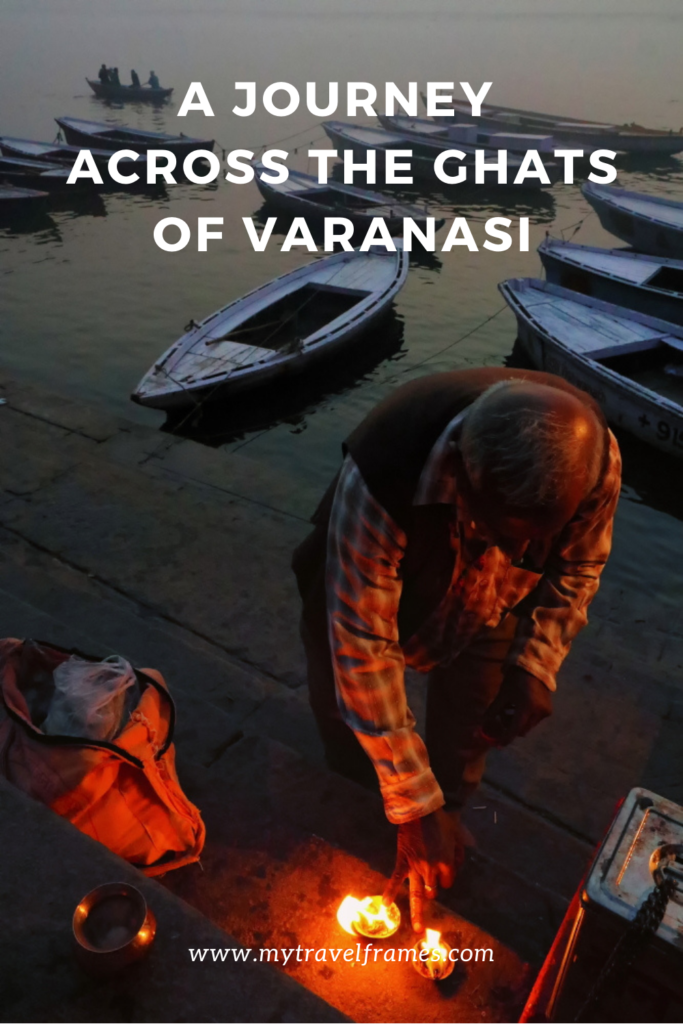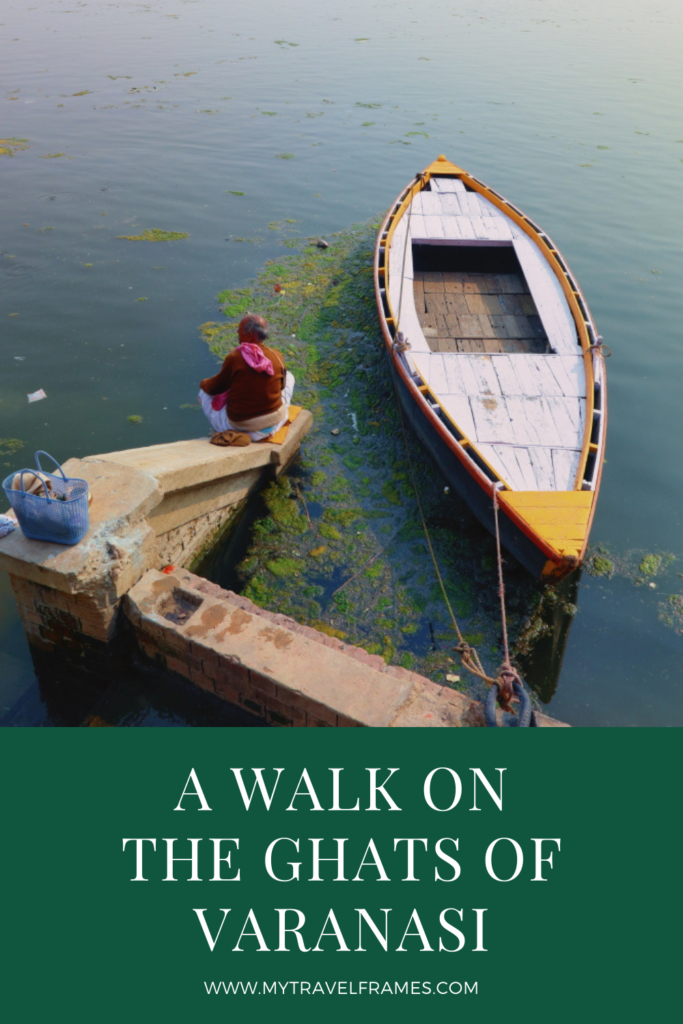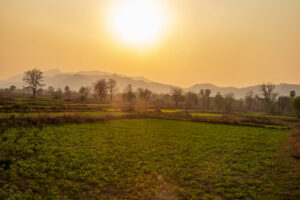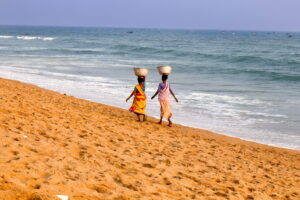Varanasi, also known as Benares (Banaras) or Kashi, is an eternal meeting place for humanity. Located on the bank of river Ganges, Varanasi has long been an important place for many religions including Hinduism, Islam, Buddhism, Jainism and Ravidassia. So in the true sense, Banaras is a “microcosm of India”. The building pillar of Indian Democracy- “the Unity in Diversity” can be felt here literally. And the easiest way to get a glimpse of this unified India is to go for a walk along the ghats of Varanasi.
The name Varanasi originates from two rivers “Varuna” and “Assi”. These two rivers respectively form the northern and the southern boundaries of this ancient city. In Rigveda, the city had been referred to as Kashi which means “City of Light” in the Sanskrit language. The 4 km distance between the two rivers, the two tributaries of Ganges, is connected by numerous ghats where one can witness the journey of the entire life cycle of the human being from birth to death, from creation to the end.

Table of Contents
A few Important Ghats of Varanasi
- The Dashashwamwdh Ghat
- The Manikarnika Ghat
- The Assi Ghat
- Tulsi Ghat
- Munshi Ghat
- Manmandir Ghat
- Scindia Ghat
- Ahilyabai Ghat
- Mansarovar Ghat
- Raja Ghat
Things To do in the Ghats Of Varanasi
Worship the Sun with the enchanting “Subah-e-Banaras” event in Assi Ghat
The best way to start your day in Varanasi is by watching the Subah-e-Banaras event in the Assi Ghat. Subah e Banaras is an early morning collective effort by the local administration to purify the mind and the soul by Vedic chanting, Ganga arati, morning raga and yoga. The programme starts every day before sunrise and continues for nearly 2 hours.
- During summer: 5-00 am to 7-00 am
- During winter: 5-40 am to 7-30 am
- Duration approx: Two hours

Embrace the magical sunrise over the Ganges
Witnessing the sunrise while the morning arati takes place in Assi Ghat is pure bliss. The rising sun, the golden Ganges and the glittering ghats create a picturesque canvas of nature. The sunrise looks more beautiful in winter when the red colour in the horizon gradually converted to yellow and lifts the veil of mist from the river and the ghats.
Enjoy the boat ride over the Ganges and see the ever happening ghats of Varanasi from the river
An early morning boat ride on the Ganges is the prime attraction of Varanasi. Sitting in a wooden rowing boat and observing the ghats from the mid-Ganges is definitely a memorable experience. You can see devotees bathing and chanting prayers standing in knee-deep water, the large Darbhanga Palace standing tall at the Munshi Ghat, the sadhus in saffron preparing for their morning pujas and the black smoke from the pyres in Manikarnika Ghat rolling upwards to the sky. During winter, the large flocks of migratory birds will accompany you while sailing in the Ganges.

The boat ride starts from many ghats but the most popular being from the Dasaswamedh Ghat. These boats are mostly rowing boats and few are run by the engine. There are also Bajras (large riverboats) which can accommodate a group of 10-25 people who can enjoy the ride sitting on the open terrace of the boat. The ride usually spans between Harischandra Ghat to Manikarnika Ghat while you can extend it till Assi Ghat on the southern side with extra charge.
Read more: Darjeeling Toy Train: My First Experience of the Famous “Joy Ride”
Visit one of the oldest Kushti Akharas of Varanasi
Do you hear the name of the famous Hindi poet Tulsidas? He is best known for his version of epic Ramayana. Tulsidas was very particular about his fitness and he used to exercise regularly in an akhara near present-day Tulsi Ghat. The Akhara is also known as Tulsi Akhara now. You can visit there in the morning and see the young trainees busy in practising.
The akhara opens around 6 in the morning. After opening, a puja is offered to the God Rama followed by exercises and weight lifting. Finally, after another hour the practising bouts of Kushti starts in the akhara. So, if you go there by 7-7:30 in the morning, you can see young pehlwans wearing a langot and covering their body with soil fighting for a bout of Kushti.

Go for leisure walking along the ghats while life gets unfolded in the stairs of Varanasi ghats
Walking past the ghats one by one beginning from the Dashaswamedh Ghat is my favourite activity whenever I go to Varanasi. The walks are mostly random, aimless and without time constraint, but I love it due to the arrays of activities I can observe while walking past the ghats. Every ghat has its own stories and purpose. While the majority of ghats are used for bathing and pujas, two of them are only used for the cremation of Hindus.
You can feel that the contrast between the happenings in these ghats are so stark yet the boundaries are so blurred. The journey from life to death seems so spontaneous and certain. And the experience as a whole is a new spiritual journey for every traveller.

Walk by Manikarnika Ghat, and realise that Death is the ultimate truth of Life
Manikarnika Ghat is one of the open cremation ghats in Varanasi, the other being Harischandra Ghat. While standing in Manikarnika Ghat, for the first time in my life I realised that death can be celebrated too. The belief is that if a Hindu is cremated here the soul will achieve moksha and breaks the cycle of rebirth which equals to more sufferings. And any mourning during the cremation draws the soul back and disrupts the process of getting it freed from all the attachments. That is why death is celebrated here willingly and openly.
Sit by Dashashwamedh Ghat and silently observe the rituals that take place there
In Dashashwamedh Ghat, you can see pujas are offered for every occasion, to celebrate the arrival of a new life, to strengthen the bonding of two newly married souls and to mourn the separation of the deceased one; literally one beside another. The place is always crowded. The priests, the devotees, the beggars, the sadhus, the tourists, the vendors, the boatmen – you will see all kind of people there. Just standing there and observing people busy in their work gives some interesting photographic opportunities as well.

Visit one of the many silk factories situated right on the ghats of Varanasi
There are many riverside old buildings literally on the steps of Varanasi ghats where you can frequently notice the phrase “silk factories” written on the walls. Your local travel guide also may take you to one of them. These silk factories are basically saree stores with one or two weaving machines installed inside to demonstrate tourists how the famous Banaras Silk sarees are made. These stores are a nice place to spend an hour learning more about the silk sarees while bargaining on the prices of your favourite ones.
Pin it to read later!

Cross to the other side of the Ganges and stroll on the sandy embankment away from all the crowds
You can take a boat from Dashashwamedh Ghat and cross the river to go to the other side. The sunset over the century-old buildings on the ghats of Varanasi looks spectacular from the other bank of Ganges, especially the way the last orange hue of the sky disappears gradually making the outline of the ghats and the buildings hazy and obscure until the street lights lit up and enlighten some of the ghats again. By then, you should go back to the Dashashwamedh Ghat to join the final attraction of the day.
Finally, be a spectator of the famous evening Ganga Aarati in Dashashwamedh Ghat
The evening aarti in Dashashwamedh Ghat is undoubtedly the most pleasing visual of the city of Varanasi for tourists. The sound of bhajans in the background with the visuals of synchronised movements of the young priests with large brass lamps and the smell of the incense sticks create an enchanting surrounding to experience. The local boatmen will suggest you to see the aarti from their boats on the river. Though the charge is little high, the panoramic view of the proceedings from a boat is beautiful nevertheless.

Some Important Landmarks of Varanasi near the Ghats
Kashi Vishwanath Temple
The famous Kashi Vishwanath Temple is very close to the Dashashwamedh Ghat. You can easily visit there in between your walk on the ghats. Usually, it takes around 1-2 hours depending on the queue. If you want to offer a puja then it will take more time to complete your visit.
Jantar Mantar / Observatory
The Observatory or Jantar Mantar built by Raja Jai Singh II of Jaipur is situated right at the bank of the Ganges over Manmandir Ghat which is adjacent to Dashashwamedh Ghat. Though the number of instruments is not so more like that of Jaipur, nevertheless you must pay a visit there and also can enjoy the majestic view of the Ganges from there.
Darbhanga Palace
The massive structure that can be seen near Munshi Ghat is Darbhanga Palace. You can not appreciate the hugeness until you see it from mid-Ganges or the other bank of Ganges. It was originally built in the year 1812 by Shridhara Narayana Munshi, the then minister for the estate of Nagpur. In 1915, King Rameshwar Singh Bahadur of Darbhanga (Bihar) acquired the palace and constructed the second floor of the palace. Today it is converted into a luxury heritage hotel and the only way to visit there is by booking a room in the hotel.

Submerged Temple of Scindia Ghat
The submerged abandoned temple near Scindia Ghat is an astonishing structure that deserves a visit. The temple was originally built more than 150 years back and was dedicated to Hindu deity Shiva, but during the construction of Scindia Ghat, the temple leaned backwards. Since then the temple is standing in such a leaning posture without collapsing.
Sankat Mochan Temple near Assi Ghat
Sankat Mochan Temple near Assi Ghat is a Hindu temple dedicated to Lord Hanuman. The temple was established by the famous Hindi poet Tulsidas. It is still visited by hundreds of devotees every day.
Photography in the Ghats of Varanasi
Photography in the ghats of Varanasi is a dream for any travel and street photographer. When I am in Varanasi, I do spend my majority time walking in the ghats of Varanasi; same stretch, same ghats, same events again and again yet I never get exhausted. That’s the charm of Varanasi to any photographer.
- The best time for photography in the ghats is during sunrise or just before sunrise. So you have to wake up early and be there at least 30 minutes before the actual time of sunrise.
- The early morning boat ride is the best if you want to capture the ghats in a wide-angle lens.
- Always take permission before you take a portrait of anyone, especially the sadhus.
- Having said that, you don’t need to ask everyone whenever you are going for a candid frame. But do remember there is always an ethical question related to the subject of your picture unless you are a professional documentary photographer.
- Do not photograph at the cremation ghats like Manikarnika and Harishchandra Ghat until someone hires you on spot.
- Do not miss the Subah-e-Banaras in Assi Ghat and the evening arati in Dashashwamedh Ghat at any cost.
- Have your lunch in one of the riverside restaurants in the ghats of Varanasi. That will give you some different framing opportunities.
- Lastly, take frequent shutter breaks. Spend some no-camera time at the ghats of Varanasi. And enjoy the street foods of Varanasi.
Pin it!





Pingback: 26 Best Places To Visit In Winter In India: Fabulous Indian Winter Destinations - Stories by Soumya